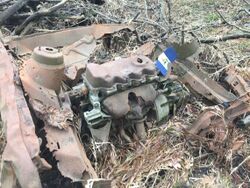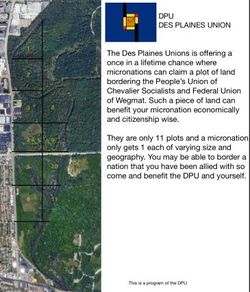Aenopian Potawatomi
Aenopian Potawatomi | |
|---|---|
Territory of Aenopia | |
 | |
| Anthem: "Gustav Holst- Jupiter" (orchestral)
| |
| Annexation from United States | 1 December 2020 |
| Government | |
| • Emperor | Simon I |
| • Governor | Cole Baird |
| Area | |
| • Total | 0.229606 km2 (0.088651 sq mi) |
| • Land | 0.088651 km2 (0.229606 sq mi) |
| • Water | 0 km2 (0 sq mi) 0% |
| Elevation | 133 m (436 ft) |
| Time zone | UTC+100 Minutes (AMT (Aenopian Mean Time)) |
Aenopian Potawatomi, also known as the Overseas Territory of Aenopian Potawatomi,[a] is a territory located within the Empire of Aenopia. Aenopian Potawatomi is surrounded by nations including Begon, Monmark, Chaveleir Union, Bonumland, Ponderosa Hills, Tesforia, Saspearian[1][2] and Paloma. Located roughly 17 miles north west of the Chicago Loop,[3] Aenopian Potawatomi is located next to the Des Plaines River and primarily consists of forest and flood plain.
Initially presented to Aenopia under the DPU Special Lands Plots program, Aenopian Potawatomi was annexed on 1 December 2020 following the passing of the 6th Territory Act. Aenopian Potawatomi was involved in the Great Des Plaines Valley War after a joint operation between the 1st Calvary Division of Rodentia and Foreign Legion of Philmont invaded numerous territories located in the area. Following the invasion of Saspearian,[2] Tesforia and Paloma, the Philmontian Army travelled towards Aenopian Potawatomi. Following the invasion of the other territories, Coalition forces led by the People's Union of Chaveleir Socialists were deployed towards the Aenopian border to defend Aenopian Potwatomi, before being forced to retreat due to heavy resistance of the invaders.
The economy of Aenopian Potawatomi mostly consists of services, specifically focusing on regional and international companies including Lobil.
Etymology
The name Aenopian Potawatomi originates from the name of the Native American people of the Great Plains, upper Mississippi River, and western Great Lakes region. This itself is derived from the Ojibwe Boodewaadamii(g) (syncoped in the Ottawa as Boodewaadmii(g)). The name Potawatomi is a translation of the Ojibwe word “potawatomink” meaning “people of the place of fire.” In their own language, the Potawatomi refer to themselves as the Nishnabek or “people.”[4]
'Aenopian Potawatomian' is the official demonym used to describe something belonging to Aenopian Potawatomi, this is also the demonym for someone from Aenopian Potawatomi. This is not to be confused with Potawatomian, which may be used to refer to something belonging to or someone from the Potawatomi Tribe.
History

Pre-history
During the early part of the Paleozoic Era, the area that would become Aenopian Potawatomi was submerged beneath a shallow sea and located near the Equator. Diverse marine life lived at this time, including trilobites, brachiopods, and crinoids. During the Pleistocene Epoch which lasted from about 2,580,000 to 11,700 years ago,[5] vast ice sheets covered much of Illinois and Aenopian Potawatomi.
Before being annexed by the Empire of Aenopia on 1 December 2020, Aenopian Potawatomi was formerly a part of Cook County, Illinois. Cook County was created on 15 January 1831, out of Putnam County by an act of the Illinois General Assembly. It was the 54th county established in Illinois and was named after Daniel Cook, one of the earliest and youngest statesmen in Illinois history.
Annexation
The territory of Aenopian Potawatomi was originally presented to the micronational community under the DPU Special Lands Plots program under the initial designation of no. 8 on 23 November 2020. Under the program, 11 plots of land surrounded by the Federal Union of Wegmat and People's Union of Chaveleir Socialists were offered to interested nations. Applications would be reviewed by the Des Plaines Union before being formally assigned to the applying nation. This project was run by Cole Baird of the Federal Union of Wegmat. An application for the plot of land was submitted by the Aenopian Government on 24 November 2020, with the plot being awarded to Aenopia on 1 December 2020. The territory of Aenopian Potawatomi was formally annexed under the 6th Territory Act the same day.[6][7]
Construction and Occupation

The territories government contracted a Weg company to construct the capital and some other buildings in the territory. The company constructed the capital of the territory; Rocinante-upon-Afon and the settlement of Maple Rush near the Western border of the province. Rocinante-upon-Afon features the capital which consists of a derelict Ford Pinto that has been sheltered more. The city also has a very small motel and a Lobil General store.
On 19 March 2021 the territory was invaded by the Philmont Confederation. The territory became a main location of the Battle for the Rainbowlands. The territory became an occupation zone of the Philmont Army after the Chaveleir Union failed to keep the territory from occupation. The Aenopian government refuses to recognize the occupation of the territory due to Aenopia’s foreign policy on microntaional war. The territory remained occupied until Rodentia's surrender agreement.
The territory remains quite reliant on the nearby Weg cities of Crystal springs, Irving and Bodwatmi, Irving. Goods are often transported from Bodwatmi to Crystal Springs where they then can be transported via boat up the river. Some trade comes up the river from the Port of Irving however most trade is conducted from a bridge crossing the Des Plaines River at the Wegmat-Chaveleir Border.
Geography
Aenopian Potawatomi is bordered by Begon to the south-west and Monmark to the south, the Chaveleir Union to the east and Bonumland to the north-west whilst an unoccupied plot of land lies to the south. Aenopian Potawatomi is also located nearby to Ponderosa Hills to the north, Tesforia, Brienia and Saspearian[1][2] to the south-west, and Paloma to the south. Aenopian Potawatomi sits on the Des Plaines river and primarily consists of forest.
Wildlife in Aenopian Potawatomi is diverse, primarily consisting of birds such as blue herons, cranes, woodpeckers and peregrine falcons. Other wildlife include bass, catfish, sunfish,[8] beavers,[9] bobcats, chipmunks, coyotes, deer, foxes, muskrats, and dragonfly.
The primary timezone of Aenopian Potawatomi is Aenopian Mean Time, whilst the territory forms part of the Central Time Zone as with the rest of the state of Illinois. The border with the Eastern Time Zone is located a short distance to the east.
Settlements
| Rocinante-upon-Afon, Aenopian Potawatomi | ||||||||||||||||||||||||||||||||||||||||||||||||||||||||||||
|---|---|---|---|---|---|---|---|---|---|---|---|---|---|---|---|---|---|---|---|---|---|---|---|---|---|---|---|---|---|---|---|---|---|---|---|---|---|---|---|---|---|---|---|---|---|---|---|---|---|---|---|---|---|---|---|---|---|---|---|---|
| Climate chart (explanation) | ||||||||||||||||||||||||||||||||||||||||||||||||||||||||||||
| ||||||||||||||||||||||||||||||||||||||||||||||||||||||||||||
| ||||||||||||||||||||||||||||||||||||||||||||||||||||||||||||
Aenopian Potawatomi is the host of two settlements - Rocinante-upon-Afon and Maple Rush, with the former being the ceremonial capital of the territory. Rocinante-upon-Afon was established on 1 December 2020 immediately after the annexation of Aenopian Potawatomi. Located on the bank of the Des Plaines River in northeastern Aenopian Potawatomi, Rocinante-upon-Afon is the administrative and economic capital of Aenopian Potawatomi and hosts a number of businesses including a motel and a Lobil General store. Numerous landmarks notable in Aenopian Potawatomi are also located in Rocinante-upon-Afon, such as the derelict Ford Pinto.
Climate
The city lies within the typical hot-summer humid continental climate (Köppen: Dfa), and experiences four distinct seasons.[10][11][12] Summers are hot and humid, with frequent heat waves. In July, temperatures in Aenopian Potawatomi average daytime highs of 29 °C (84 °F), and nighttime lows of 20 °C (68 °F); and January daytime highs of −1 °C (30 °F), and nighttime lows of −8 °F (−22 °C). Winter temperatures will sometimes veer above 4 °C (39 °F), and, although not common, have also risen over 10 °C (50 °F) on some winter days. Average monthly precipitation ranged from 109 millimetres (4.3 in) in June to 45 millimetres (1.8 in) in February.[13]
Transportation

Rail
Aenopian Potawatomi is located approximately 1 mile (1.6 km) from Rosemont station (CTA) on the Chicago "L" rapid transit system. and 0.93 miles (1.5 km) from Schiller Park station on the North Central Line with services operated by Metra. Rosemont station (CTA) is located on the Blue Line (CTA) and is located approximately (2.18 km) from O'Hare station which acts as the terminus of the line. Trains are scheduled to depart from Rosemont every 2–7 minutes during rush-hour periods, and typically take about 36 minutes to travel to the Loop.
Schiller Park station is located on the North Central Commuter line and serves the village of Schiller Park, Illinois.[14] The station is 17.4 miles (28.0 km) away from Chicago Union Station, the southern terminus of the line.[15]
Aviation
Aenopian Potawatomi is located approximately 2.25 miles (4.1 km) from O'Hare International Airport however is located only 1.37 miles (2.2 km) from the end of runway 28R. O'Hare International Airport has approximately 568 daily direct flights to 154 U.S. cities and approximately 45 daily direct flights to 38 international destinations, as of September 2020.[16] Services are operated by a total of 51 airlines consisting of a mix between domestic and international routes.[17][18]
Culture
Aenopian culture primarily follows the basic principles of the Western culture due to its geographical location in the world and subsequently, its population. Some Christian holidays which have become embedded into Western society (Christmas, Easter, etc.) are recognised and celebrated by the population as National Holidays. Aenopian Potawatomi also adheres to these principles as a territory of Aenopia.
Languages
English is the most commonly spoken language in Aenopia and the only language used on a daily basis for communication; it is the only language used for government and diplomatic business, although Welsh is rarely used for more ceremonial occasions and is featured as a secondary language on numerous Aenopian documents and treaties. Aenopia also ceremoniously recognises Welsh as a national language.
Sister Cities
Rocinante-upon-Afon is an active participant in the Cupertino Twin Towns project, after being paired with 3 cities on 1 May 2021.
Rocinante-upon-Afon is twinned with:
|
See also
Notes
- ↑ Referred to as an Overseas Territory due to its isolation in comparison to other Aenopian territories.
References
- ↑ 1.0 1.1 SBC News. ""Annexation of Saspeariard Illinois"". Archived from the original on 12 April 2021.
- ↑ 2.0 2.1 2.2 SBC News. ""Saspearian Government declares diplomatic support to Wegmat in the Great Des Plaines Valley War"". Archived from the original on 12 April 2021.
- ↑ Rome2Rio. ""How to get from Chicago to Rosemont by train, subway, taxi or car"". Archived from the original on 14 April 2021.
- ↑ Legends of America. ""The Potawatomi Tribe – Legends of America"". Archived from the original on 20 December 2020.
- ↑ "Major Divisions". Subcommission on Quaternary Stratigraphy. International Commission on Stratigraphy. Retrieved 25 September 2019.
- ↑ Aenopian Hour. ""Aenopia reaches new world; 6th territory annexed"". Archived from the original on 20 December 2020.
- ↑ Aenopian Government. ""6th Territory Act"". Archived from the original on 20 December 2020.
- ↑ "Des Plaines River". Illinois Department of Natural Resources.
- ↑ Village of River Woods. ""The Des Plaines River – A Nature Lover's Paradise"". Archived from the original on 16 April 2021.
- ↑ "Climate of Chicago – Illinois State Climatologist". Retrieved March 24, 2020.
- ↑ Mölders, Nicole; Kramm, Gerhard (July 5, 2014) (in en). Lectures in Meteorology. Springer. ISBN 978-3-319-02144-7. https://books.google.com/books?id=nWr1AwAAQBAJ&q=hot-summer+humid+continental+climate+CHICAGO&pg=PA521.
- ↑ "Chicago, Illinois Köppen Climate Classification (Weatherbase)". Weatherbase. Retrieved March 24, 2020.
- ↑ Weather.com. ""Weather in Chicago, Il"". Archived from the original on 14 April 2021.
- ↑ Metra rail. ""Sciller Park"". Archived from the original on 19 December 2020.
- ↑ Metra Railfan Tips - North Central Service
- ↑ Fly Chicago. ""Non Stop service"". Archived from the original on 19 December 2020.
- ↑ Fly Chicago. ""INTLnonstops"" (PDF). Archived from the original (PDF) on 19 December 2020.
- ↑ Fly Chicago. ""DOMnonstops"" (PDF). Archived from the original (PDF) on 19 December 2020.
